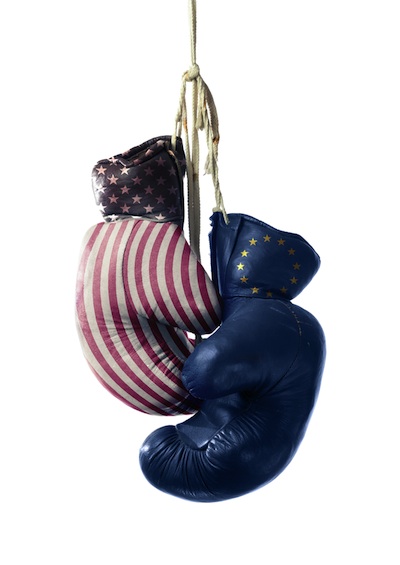TTIP and Food Safety
Why transatlantic negotiators worry about another chicken war.

Credit: Gutzemberg - Shutterstock.com
Takeaways
- There is nothing TTIP negotiators fear more than another Chicken War.
- Chickens have become the epitome of transatlantic frictions over trade and consumer preferences.
- The EU defends its strict policy with consumer health in TTIP negotiations.
- U.S. industry representatives see the EU regulations as a pure trade obstacle.
As the United States and the EU push ahead on their talks about a free trade agreement, there is nothing that negotiators on both sides fear more than another Chicken War.
But try as they may to stop it, this war is already being waged. Public debate in Germany over the “Chlorhuhn,” the chlorinated chicken, has drowned out every other aspect of the proposed Transatlantic Trade and Investment Agreement. The topic was even picked up by the Heute-Show, a German adaptation of Jon Stewart’s Daily Show. The episode shows a reporter eating chicken nuggets in the White House kitchen and mockingly praising the “slight aroma of kiddie pool.”
Chickens have become the epitome of transatlantic frictions over trade and consumer preferences. In the United States, chicken meat is sanitized with chlorine. The EU only allows sanitization with water – and therefore bans most chicken exports from the United States.
Consumer health over all else
The EU defends its strict policy with consumer health – the fear that chlorine can cause cancer – as well as animal welfare. If only water is allowed, the responsibility is on the farmer to have clean production standards – and farms are regularly checked for salmonella among their chicken stock.
U.S. industry representatives see the EU regulations as a pure trade obstacle and criticize the European arguments as unscientific. They claim there is no proof that the amounts of chlorine used to sanitize chicken meat harms the consumer. They point out that 120 other countries around the world accept the U.S. practice – and they note that other products, such as lettuce, are rinsed in chlorine in the EU as well.
Free trade proponents in Germany are trying to reassure consumers. This September, the Cologne Institute of Economic Research presented findings of the German Federal Institute for Risk Assessment which found no scientific proof that chicken disinfected with chlorine can be a health hazard.
Better safe than sorry?
But even if there is no scientific consensus on the harmfulness of a product, the EU can still ban it based on the “precautionary principle”. In the world as it is seen from Brussels, a suspected health risk is enough.
The precautionary principle has been the object of much derision in trade circles in Washington. But negotiators learned the hard way not to ignore public opinion when it comes to food. A previous attempt to lift the chlorine chicken ban was crushed in 2008 by a coalition of European consumers and agriculture ministers.
To the chagrin of many U.S. producers, chlorinated chicken meat is not the only agricultural product that Europeans are deeply skeptical of. Just recently, the freshness coating containing DPA in U.S. apples has made some headlines. In the EU, the use of the chemical to prevent fruit from turning brown has been banned since 2012.
European consumers are equally terrified of the potential health effects of genetically modified corn and soybeans and of growth-hormones in beef – two other sources of constant transatlantic friction.
Just like the Chicken Wars, the dispute over beef has been raging ever since the EU banned the use of hormones in 1990. In 1996, the World Trade Organization ruled in favor of the United States and allowed it to apply retaliatory tariffs on a range of European food products. The fight escalated again in 1999, when the U.S. temporarily tripled the tariff on Roquefort cheese from 100 to 300%.
Compromise is not impossible
For the TTIP talks, which are going into their seventh round this week, both sides are negotiating in separate groups to deal with agriculture and the related “sanitary and phyto-sanitary measures,” such as the regulations for sanitizing meat.
Compromise on any of these issues is difficult but not impossible. In a sign of goodwill, the EU approved the sanitization of beef with lactic acid early last year, one of four substances other than water that U.S. slaughterhouses use to clean meat. The step was seen as a goodwill gesture to get the negotiations launched.
The United States, for its part, agreed to lift its ban on European beef imports based on fears of mad cow disease in the 1980s – giving rise to warnings in Europe that American negotiators will demand an easing of the hormone ban in return.
Given the strong resistance against such a step in the EU, the more realistic scenario is that the EU will raise the duty-free import quota for hormone-free American beef – as it agreed to do in its trade agreement with Canada.
But while there is some movement on the beef front, one thing is sure: Nobody at the negotiating table will want to talk about chickens.



























